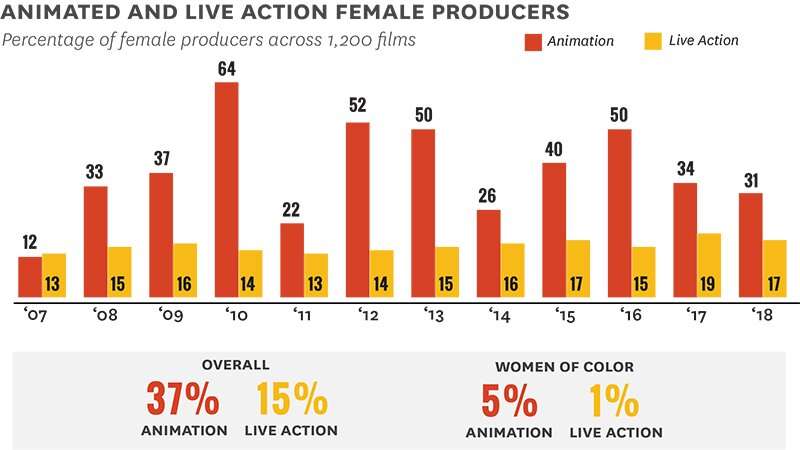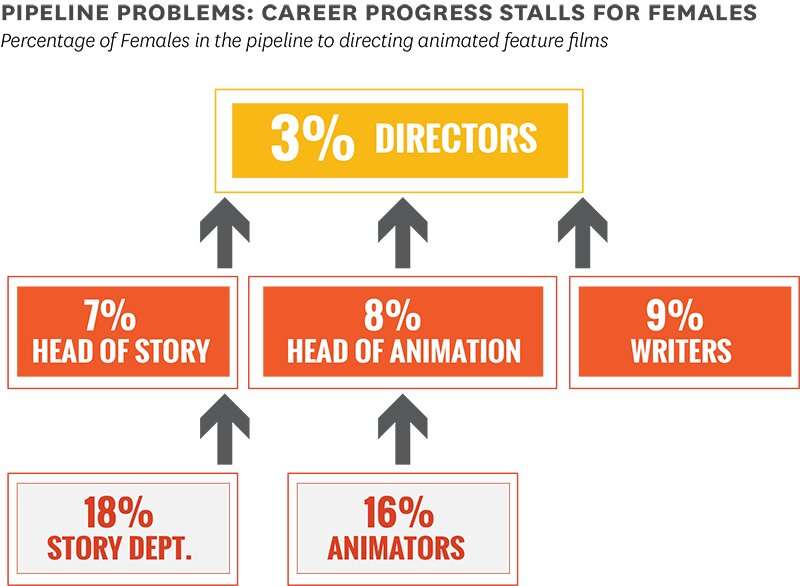Despite positive trends, women remain underrepresented in animation

A new study examines the ecosystem of the animation industry and finds pluses and minuses for women in the field.
As the animation industry gathers for the Annecy International Animation Film Festival, a new study examines the state of inclusion for women in the business. The results suggest that there have been gains, but there is much more work to be done, particularly for women of color.
The report, titled "Inclusion in Animation," is the most comprehensive and in-depth analysis of entertainment with a focus on animation from Dr. Stacy L. Smith and the USC Annenberg Inclusion Initiative to investigate the topic. The investigation was conducted in partnership with Women in Animation and will be presented for the first time today at the Women in Animation World Summit in Annecy, France. The quantitative study examined animation across film and popular TV series, evaluating the prevalence of women above and below the line in key roles, and in the executive ranks across major companies and studios. The pipeline for women in animation was assessed across prestigious animation programs and animated short films at premiere festivals. The report also includes a qualitative investigation, which consists of 75 in-depth interviews with early-career women and decision-makers, as well as survey data from more than 250 individuals in the Animation Guild. The report concludes with solutions to inequality in organizations connected to the animation industry.
The quantitative results reveal a few positive trends. First, women make up roughly half of the executives in animation and fully half of the most powerful positions in major film animation companies and studios. Second, data from animation programs and film festivals reveals that a robust pipeline exists from animation classrooms into early career.
"Another area in which we see some progress is with female producers of animated films," Smith said. "In the last 12 years, 37 percent of producers of animated movies were women, while for live-action films, the figure was 15 percent. The proportion of women in this leadership role in animation, and the progress made in the last decade indicates that there are spaces where the industry is taking inclusion seriously and affecting change. However, only 5 percent of producers of animated films and 1 percent of live-action producers were women of color. The movie industry is completely out of step with the audience in this regard."
Data on film directors and unit heads in animated movies and TV series suggest that once women enter the animation field, they opt out or are pushed to other work as they navigate the career paths to this prominent creative job. Only 3 percent of animated film directors over the last 12 years were women, while 13 percent of episodes evaluated across popular animated TV programs from 2018 had female directors. Only 1 female film director and 3 female TV directors were women from underrepresented racial/ethnic backgrounds.

"Women from a variety of racial/ethnic backgrounds were not working as directors across film or TV," Smith said. The lack of Black or African American women, Hispanic/Latina women, Native women, or women from Middle East/North African communities, multi-racial or other groups means that the voices and stories of animated films and programs reflect a very narrow demographic of storytellers.
In contrast to film, 20 percent of executive producers, 17 percent of co-executive producers, and 34 percent of producers in TV were women. Only 6 women of color were executive producers, while 8 percent of producers were women from underrepresented racial/ethnic backgrounds. Seventeen percent of "Created by" or "Developed by" credits in TV were held by women, with just 3 earned by women of color.
In below-the-line roles, women are still outnumbered in film and TV. Across 52 top animated films from the past 5 years, only 7 percent of head of story positions were filled with women, as were 8 percent of animation heads and 14 percent of art directors. Women of color held 6 percent, 3 percent, and 4 percent of these positions, respectively. Across 100 popular animated TV series, women made up 16 percent of animation directors, 20 percent of lead animators, and 11 percent of lead storyboard artists. Slightly higher percentages of women of color were observed in these roles in comparison to film, as 8 percent, 13 percent, and 3 percent of positions across these respective jobs went to women from underrepresented racial/ethnic backgrounds.
"This study validates what we have known all along, that women are a hugely untapped creative resource in the animation industry," adds Marge Dean, president of Women in Animation. "Now that we have a greater understanding of how the numbers fall into place and what solutions may help rectify this deficiency, we can take bigger strides towards our goal of 50-50 by 2025."
Results from the qualitative analysis demonstrate the major impediments facing women in the animation industry. Responses indicated that a male-dominated and masculine culture affects women, that the industry view of women is less valuable, and that women are perceived to be less interested in the field. Unique impediments facing women of color were also explored, namely the negative consequences that emerge from being a "token," including feelings of isolation.
"One sentiment that emerged from the qualitative responses was a sense of distrust and skepticism from animation industry members about current efforts surrounding inclusion," said Dr. Katherine Pieper, one of the study authors. "As organizations and individuals grapple with how to support and extend the careers of women in the industry, including women from all backgrounds and communities, the goal must be to ensure that everyone feels a sense of belonging and that men and women are committed to target inclusion goals and working collectively toward achieving them."
Further study results will be unveiled at the third annual Women in Animation World Summit, held in partnership with Les Femmes s"Animant (LFA), at the Annecy International Animation Festival and Mifa 2019.
More information: The report is available online: assets.uscannenberg.org/docs/a … animation-201906.pdf
Provided by University of Southern California


















